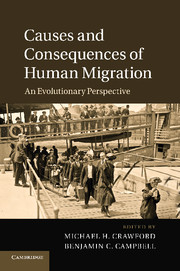Book contents
- Frontmatter
- Contents
- Contributors
- Preface
- 1 Perspectives on human migration: introduction
- Section 1 Theory
- Section 2 Geography and migration
- 8 Population structure and migration in Africa: correlations between archaeological, linguistic, and genetic data
- 9 Human migrations in North Africa
- 10 Identity, voice, community: new African immigrants to Kansas
- 11 The African colonial migration into Mexico: history and biological consequences
- 12 Demic expansion or cultural diffusion: migration and Basque origins
- 13 Consequences of migration among the Roma: immunoglobulin markers as a tool in investigating population relationships
- 14 Migration, assimilation, and admixture: genes of a Scot?
- 15 Mennonite migrations: genetic and demographic consequences
- 16 Human migratory history: through the looking-glass of genetic geography of Mycobacterium tuberculosis
- 17 Peopling the Tibetan plateau: migrants, genes, and genetic adaptations
- 18 Migration, globalization, instability, and Chinese in Peru
- 19 The great blue highway: human migration in the Pacific
- 20 Migration of pre-Hispanic and contemporary human Mexican populations
- 21 A review of the Tupi expansion in the Amazon
- 22 Molecular consequences of migration and urbanization in Peruvian Amazonia
- 23 Migration in Afro-Brazilian rural communities: crossing historical, demographic, and genetic data
- 24 Indentured migration, gene flow, and the formation of the Indo-Costa Rican population
- 25 Causes and consequences of migration to the Caribbean Islands and Central America: an evolutionary success story
- Section 3 Overview
- Index
- References
16 - Human migratory history: through the looking-glass of genetic geography of Mycobacterium tuberculosis
Published online by Cambridge University Press: 05 December 2012
- Frontmatter
- Contents
- Contributors
- Preface
- 1 Perspectives on human migration: introduction
- Section 1 Theory
- Section 2 Geography and migration
- 8 Population structure and migration in Africa: correlations between archaeological, linguistic, and genetic data
- 9 Human migrations in North Africa
- 10 Identity, voice, community: new African immigrants to Kansas
- 11 The African colonial migration into Mexico: history and biological consequences
- 12 Demic expansion or cultural diffusion: migration and Basque origins
- 13 Consequences of migration among the Roma: immunoglobulin markers as a tool in investigating population relationships
- 14 Migration, assimilation, and admixture: genes of a Scot?
- 15 Mennonite migrations: genetic and demographic consequences
- 16 Human migratory history: through the looking-glass of genetic geography of Mycobacterium tuberculosis
- 17 Peopling the Tibetan plateau: migrants, genes, and genetic adaptations
- 18 Migration, globalization, instability, and Chinese in Peru
- 19 The great blue highway: human migration in the Pacific
- 20 Migration of pre-Hispanic and contemporary human Mexican populations
- 21 A review of the Tupi expansion in the Amazon
- 22 Molecular consequences of migration and urbanization in Peruvian Amazonia
- 23 Migration in Afro-Brazilian rural communities: crossing historical, demographic, and genetic data
- 24 Indentured migration, gene flow, and the formation of the Indo-Costa Rican population
- 25 Causes and consequences of migration to the Caribbean Islands and Central America: an evolutionary success story
- Section 3 Overview
- Index
- References
Summary
Introduction
Tuberculosis that is caused by Mycobacterium tuberculosis is an ancient disease that plagued humankind throughout its history and prehistory (Daniel, 2006). The oldest examples of spinal TB, in the form of fossil bones, date back to about 8000 BC (reviewed in Herzog, 1998). Findings in Egyptian mummies indicate that spinal caries existed around 2400 BC (Zink et al., 2003). The legal text formulated by the Babylonian king Hammurabi 3900 years ago mentions a chronic lung disease, which could be TB. The famous “plague of Justinian” could be at least partly due to invasion of the Mediterranean urban cultures by young people from northern and eastern Europe who had never before come into contact with TB (Herzog, 1998). The first mention of TB in Chinese literature appears in a medical text written by Emperor Shennong of China (2700 BCE) describing xulao bing (weak consumption), which is believed to be TB (Yang, 1998). In East Asia/Far East (including China, Korea, and Japan), the earliest case of paleopathologically confirmed TB so far reported is from Hunan province in China in a female wet cadaver dated to about 200 BC, in the Western Han dynasty in the Kingdom of Changsha (Suzuki and Inoue, 2007 and references therein). TB has been endemic in Europe for a much longer period and reached epidemic proportions during the eighteenth and nineteenth centuries (TB mortality in the early 1800s in England was > 500/100 000) due to especially adverse social conditions until it began to decline from about 1870 onwards (Murray, 2004). Therefore, the East Asian long-term endemic coexistence with M. tuberculosis is apparently independent of the relatively recent medieval European TB epidemics. Finally, most recently, modern TB reached the coastal people of Africa only in about 1910; it has been noticed that black populations have higher rates of TB and are also more likely to develop the more fulminant forms of the disease (reviewed in Bellamy, 1998; Stead, 1997).
Mycobacterium tuberculosis sensu stricto (M. tuberculosis) is a strictly human pathogen. The tubercle bacillus has the remarkable ability to persist in the human host in the form of a long-term asymptomatic infection referred to as latent TB. One third of the world population is estimated to have a latent TB infection.
- Type
- Chapter
- Information
- Causes and Consequences of Human MigrationAn Evolutionary Perspective, pp. 317 - 341Publisher: Cambridge University PressPrint publication year: 2012
References
- 5
- Cited by



